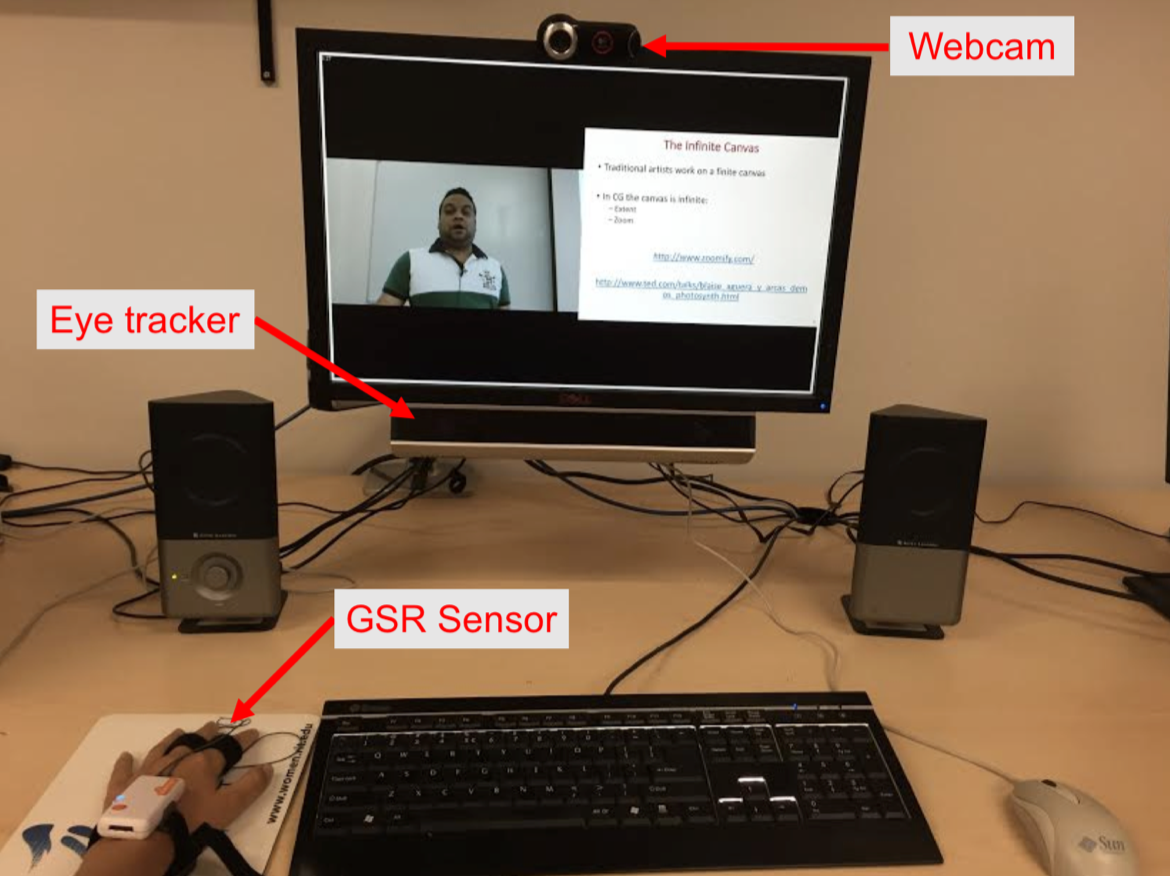 Online
learning has gained increased popularity in recent years. However,
with online learning, teacher observation and inter- vention is
lost, creating a need for technologically observable
characteristics that can compensate for this limitation. The
present study used a wide array of sensing mechanisms including
eye tracking, galvanic skin response (GSR) recording, facial
expression analysis, and summary note-taking to monitor
participants while they watched and recalled an online video
lecture. We explored the link between these human- elicited
responses and learning outcomes as measured by quiz questions.
Results revealed GSR to be the best indicator of the challenge
level of the lecture material. Yet, eye tracking and GSR remain
difficult to capture when monitoring online learn- ing as the
requirement to remain still impacts natural behavior and leads to
more stoic and unexpressive faces. Continued work on methods
ensuring naturalistic capture are critical for broadening the use
of sensor technology in online learning, as are ways to fuse these
data with other input, such as structured and unstructured data
from peer-to-peer or student-teacher interactions. Online
learning has gained increased popularity in recent years. However,
with online learning, teacher observation and inter- vention is
lost, creating a need for technologically observable
characteristics that can compensate for this limitation. The
present study used a wide array of sensing mechanisms including
eye tracking, galvanic skin response (GSR) recording, facial
expression analysis, and summary note-taking to monitor
participants while they watched and recalled an online video
lecture. We explored the link between these human- elicited
responses and learning outcomes as measured by quiz questions.
Results revealed GSR to be the best indicator of the challenge
level of the lecture material. Yet, eye tracking and GSR remain
difficult to capture when monitoring online learn- ing as the
requirement to remain still impacts natural behavior and leads to
more stoic and unexpressive faces. Continued work on methods
ensuring naturalistic capture are critical for broadening the use
of sensor technology in online learning, as are ways to fuse these
data with other input, such as structured and unstructured data
from peer-to-peer or student-teacher interactions.
|
| Collaborators
|
|
|
| Publications
|
|
|
 Online
learning has gained increased popularity in recent years. However,
with online learning, teacher observation and inter- vention is
lost, creating a need for technologically observable
characteristics that can compensate for this limitation. The
present study used a wide array of sensing mechanisms including
eye tracking, galvanic skin response (GSR) recording, facial
expression analysis, and summary note-taking to monitor
participants while they watched and recalled an online video
lecture. We explored the link between these human- elicited
responses and learning outcomes as measured by quiz questions.
Results revealed GSR to be the best indicator of the challenge
level of the lecture material. Yet, eye tracking and GSR remain
difficult to capture when monitoring online learn- ing as the
requirement to remain still impacts natural behavior and leads to
more stoic and unexpressive faces. Continued work on methods
ensuring naturalistic capture are critical for broadening the use
of sensor technology in online learning, as are ways to fuse these
data with other input, such as structured and unstructured data
from peer-to-peer or student-teacher interactions.
Online
learning has gained increased popularity in recent years. However,
with online learning, teacher observation and inter- vention is
lost, creating a need for technologically observable
characteristics that can compensate for this limitation. The
present study used a wide array of sensing mechanisms including
eye tracking, galvanic skin response (GSR) recording, facial
expression analysis, and summary note-taking to monitor
participants while they watched and recalled an online video
lecture. We explored the link between these human- elicited
responses and learning outcomes as measured by quiz questions.
Results revealed GSR to be the best indicator of the challenge
level of the lecture material. Yet, eye tracking and GSR remain
difficult to capture when monitoring online learn- ing as the
requirement to remain still impacts natural behavior and leads to
more stoic and unexpressive faces. Continued work on methods
ensuring naturalistic capture are critical for broadening the use
of sensor technology in online learning, as are ways to fuse these
data with other input, such as structured and unstructured data
from peer-to-peer or student-teacher interactions.